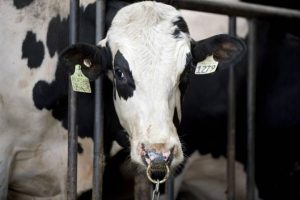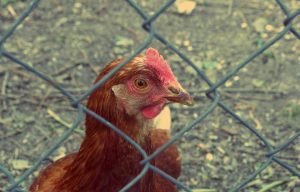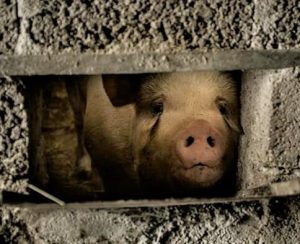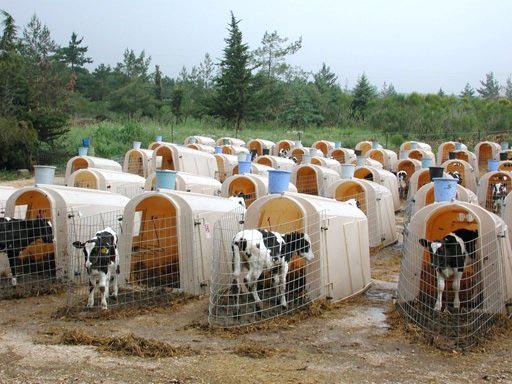 Shelter-in-place restrictions, closed businesses and public spaces, and reduced social interaction has found us confronting unfamiliar feelings of alienation and isolation. Many people are disoriented by the sense of being estranged from their own lives.
Shelter-in-place restrictions, closed businesses and public spaces, and reduced social interaction has found us confronting unfamiliar feelings of alienation and isolation. Many people are disoriented by the sense of being estranged from their own lives.
Weeks or months of isolation necessary to inhibit the spread of the COVID-19 virus can be uncomfortable, but we know this disruption in our lives is only temporary. Try to imagine, if you can, the depths of isolation our society routinely inflicts on so many of our fellow beings – the nonhuman animals we breed or capture for our exploitation. For the animals languishing on farms, in zoos, vivisection laboratories, aquariums, circuses, pet stores, breeding mills, kill shelters, alienation and loneliness is the very essence of their existence, and a permanent condition.
 It is widely believed that COVID-19 jumped to humans via the animal flesh trade, which has led to a critical focus on wildlife and “wet” markets. Deservedly so, but we must not forget that factory farms and meat packing plants remain the largest sources of human zoonotic disease pandemics. A 2012 study mapping human diseases that come from animals found that “while zoonoses can be transmitted to people by either wild or domesticated animals, most human infections are acquired from the world’s 24 billion livestock, including pigs, poultry, cattle, goats, sheep and camels.”
It is widely believed that COVID-19 jumped to humans via the animal flesh trade, which has led to a critical focus on wildlife and “wet” markets. Deservedly so, but we must not forget that factory farms and meat packing plants remain the largest sources of human zoonotic disease pandemics. A 2012 study mapping human diseases that come from animals found that “while zoonoses can be transmitted to people by either wild or domesticated animals, most human infections are acquired from the world’s 24 billion livestock, including pigs, poultry, cattle, goats, sheep and camels.”
 The World Health Organization confirms that the greatest risk for zoonotic disease transmission occurs at the human-animal interface through direct or indirect human exposure to animals, their products (meat, milk, eggs, etc.) and/or their environments, while the United Nations Food and Agriculture Organization notes that “seventy percent of the new diseases that have emerged in humans over recent decades are of animal origin and, in part, directly related to the human quest for more animal-sourced food.”
The World Health Organization confirms that the greatest risk for zoonotic disease transmission occurs at the human-animal interface through direct or indirect human exposure to animals, their products (meat, milk, eggs, etc.) and/or their environments, while the United Nations Food and Agriculture Organization notes that “seventy percent of the new diseases that have emerged in humans over recent decades are of animal origin and, in part, directly related to the human quest for more animal-sourced food.”
Just a decade ago, swine flu, an H1N1 influenza virus, jumped from farmed pigs to humans and infected nearly 61 million people in the U.S. alone, where it resulted in 12,469 deaths, according to The Centers for Disease Control and Prevention (CDC). Worldwide, as many as 284,500 people were killed by the swine flu pandemic.
 The infamous 1918 influenza pandemic was also caused by an H1N1 virus. Attributed to having developed from either a swine flu or avian flu virus on a pig or poultry farm (pre-dating factory farms, it should be noted), the pandemic killed an estimated 50 million people around the world.
The infamous 1918 influenza pandemic was also caused by an H1N1 virus. Attributed to having developed from either a swine flu or avian flu virus on a pig or poultry farm (pre-dating factory farms, it should be noted), the pandemic killed an estimated 50 million people around the world.
All this is just the tip of the iceberg.
While pandemics are tragic, they are not inevitable. In the grand scheme of things, they are symptoms of a much deeper sickness with which we have infected not only ourselves, but whose toxic consequences can now be seen across the globe. Witness the burning of the Amazon rainforest to make room for ever more cattle ranching. See Australia, where the ceaseless bulldozing of koala habitat and the deliberate mass killing of kangaroos, both on behalf of the beef industry, kill far more of these animals every year than the recent wildfires. See, too, the unprecedented rates of species extinction resulting from habitat loss, whose number one driver is animal agriculture; the climate crisis to which meat and dairy production contribute more greenhouse gas emissions than all global transport combined, leading to devastating droughts, floods, fires, hurricanes, and other extreme weather events.
 This sickness is not the scale of our killing but in the mentality that views animals not as fellow beings but as resources to be farmed and consumed. Humans have thrown out the order of nature and taken it upon themselves to decide where animals will live, if they may reproduce and how and when, if the children they bear will ever see their mothers, when or if they may be allowed to socialize with their own species. What, when, and how much they will eat, what mutilations they will be subjected to, and, to a great extent, when and how they will die.
This sickness is not the scale of our killing but in the mentality that views animals not as fellow beings but as resources to be farmed and consumed. Humans have thrown out the order of nature and taken it upon themselves to decide where animals will live, if they may reproduce and how and when, if the children they bear will ever see their mothers, when or if they may be allowed to socialize with their own species. What, when, and how much they will eat, what mutilations they will be subjected to, and, to a great extent, when and how they will die.
What can it mean that, in a society obsessed with personal identity and freedom, we have erased the very concepts of identity, liberty, autonomy, and consent from entire populations of sentient individuals. We give little or no thought to the moral implications of the indignity and debasement we inflict on them for our own profit and pleasure. To degrade any individual, much less entire species, to the lifelong status of property, captive, and commodity, is the grossest devaluing of life, and the ultimate alienation.
Farmed animals are the innocent victims of our arrogant and ignorant species. They do not “live” as we know and value the word; they endure an existence. They are powerless, brought into the world by violation on an industrial scale for the sole purpose of gratifying human indulgence.
It doesn’t have to be this way. We can thrive without causing this devastating harm.
It is no coincidence that our systematic destruction of animal lives is also destroying our own. As I write this, U.S. slaughterhouses and meat processing plants have been identified as the largest hotspot for coronavirus infection in the country. Instead of shutting them down to stop the spread of this killer virus, an executive order is forcing them to stay open to supply our society’s fetish for flesh. Headlines fan the fears of “mass meat shortage” that threaten to starve us all. News flash: it won’t. There are more than enough things to eat that aren’t hacked off the corpses of animals.
Our culture is in a state of addiction. It is pathological. And it is wrecking our planet, which ought to be incidental to the immorality of force-breeding billions of sentient individuals into captivity, reproductive subjugation, and slaughter. Lives are not commodities; beings are not property.
Until we divest from this poisonous sense of entitlement, this blood-soaked stupor of violence, exploitation, and consumption, our species is doomed.
Peace to ALL the animals with whom we share this planet.
